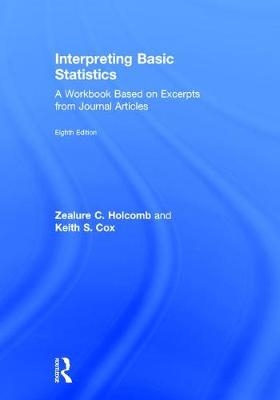
Interpreting Basic Statistics
A Workbook Based on Excerpts from Journal Articles
Seiten
2017
|
8th edition
Routledge (Verlag)
978-0-415-78796-3 (ISBN)
Routledge (Verlag)
978-0-415-78796-3 (ISBN)
- Titel erscheint in neuer Auflage
- Artikel merken
Zu diesem Artikel existiert eine Nachauflage
Interpreting Basic Statistics gives students valuable practice in interpreting statistical reporting as it actually appears in peer-reviewed journals.
New to the 8th edition: New exercises and journal excerpts show how to interpret a greater array of statistical reporting to reflect the recent focus on New Statistics.
Interpreting Basic Statistics gives students valuable practice in interpreting statistical reporting as it actually appears in peer-reviewed journals.
New to the eighth edition:
A broader array of basic statistical concepts is covered, especially to better reflect the New Statistics.
Journal excerpts have been updated to reflect current styles in statistical reporting.
A stronger emphasis on data visualizations has been added.
The statistical exercises have been re-organized into units to facilitate ease of use and understanding.
About this book
Each of the 64 exercises gives a brief excerpt of statistical reporting from a published research article, and begins with guidelines for interpreting the statistics in the excerpt.
The questions on the excerpts promote learning by requiring students to
interpret information in tables and figures,
perform simple calculations to further their interpretations,
critique data-reporting techniques, and
evaluate procedures used to collect data.
Each exercise covers a limited number of statistics, making it easy to coordinate the exercises with lectures and a main textbook.
The questions in each exercise are divided into two parts: (1) Factual Questions and (2) Questions for Discussion. The factual questions require careful reading for details, while the discussion questions show that interpreting statistics is more than a mathematical exercise. These questions require students to apply good judgment as well as statistical reasoning in arriving at appropriate interpretations.
New to the 8th edition: New exercises and journal excerpts show how to interpret a greater array of statistical reporting to reflect the recent focus on New Statistics.
Interpreting Basic Statistics gives students valuable practice in interpreting statistical reporting as it actually appears in peer-reviewed journals.
New to the eighth edition:
A broader array of basic statistical concepts is covered, especially to better reflect the New Statistics.
Journal excerpts have been updated to reflect current styles in statistical reporting.
A stronger emphasis on data visualizations has been added.
The statistical exercises have been re-organized into units to facilitate ease of use and understanding.
About this book
Each of the 64 exercises gives a brief excerpt of statistical reporting from a published research article, and begins with guidelines for interpreting the statistics in the excerpt.
The questions on the excerpts promote learning by requiring students to
interpret information in tables and figures,
perform simple calculations to further their interpretations,
critique data-reporting techniques, and
evaluate procedures used to collect data.
Each exercise covers a limited number of statistics, making it easy to coordinate the exercises with lectures and a main textbook.
The questions in each exercise are divided into two parts: (1) Factual Questions and (2) Questions for Discussion. The factual questions require careful reading for details, while the discussion questions show that interpreting statistics is more than a mathematical exercise. These questions require students to apply good judgment as well as statistical reasoning in arriving at appropriate interpretations.
Keith S. Cox is a Clinical and Personality Psychologist. He teaches research methods and statistics at the University of North Carolina, Asheville, where he holds the rank of assistant professor. He uses research methods and statistics as he investigates posttraumatic stress disorder (PTSD) and personality.
Preface
Unit I. Basic Descriptions of the Data: Measurement and Frequency
Unit II. Describing the Data
Unit III. Displaying Data: Visualizing What is There
Unit IV. Finding Relationships: Association and Prediction
Unit V. Testing Predictions with Normal Distributions
Unit VI. Nonparametric Tests for Group Differences
Unit VII. Test Construction
| Erscheinungsdatum | 27.08.2017 |
|---|---|
| Verlagsort | London |
| Sprache | englisch |
| Maße | 178 x 254 mm |
| Gewicht | 589 g |
| Themenwelt | Geisteswissenschaften ► Psychologie |
| ISBN-10 | 0-415-78796-3 / 0415787963 |
| ISBN-13 | 978-0-415-78796-3 / 9780415787963 |
| Zustand | Neuware |
| Haben Sie eine Frage zum Produkt? |
Mehr entdecken
aus dem Bereich
aus dem Bereich
eine Psychiaterin spricht offen über ihre Bipolare Störung und zeigt, …
Buch | Softcover (2023)
Eden Books (Verlag)
CHF 29,90
Erfahrungen eines Psychoanalytikers
Buch | Softcover (2023)
Schattauer (Verlag)
CHF 30,80



